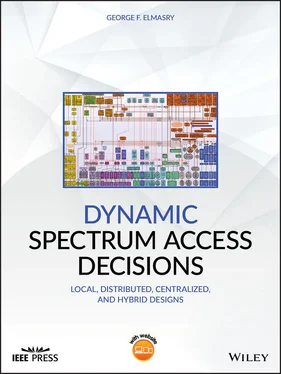One can see from Figure 3.2that as SNIR increases, 6we can achieve higher P Dat lower P F. While one can see the same tendency in demodulation and decoding of a signal where higher SNIR results in less symbol error probability, it is critical to understand that this energy detection process relies on estimating the noise variance. Noise power estimation error can cause significant performance loss (significant shift in λ Ein Figure 3.1). Noise level can be estimated dynamically and more accurately if the spectrum sensor is able to separate the noise subspace from the signal subspace. Some sensors estimate noise variance as the smallest eigenvalue of the sensed signal's autocorrelation. This estimated noise variance can then be used to find the decision threshold λ Ethat satisfies the requirements for a given false alarm rate. This noise estimation algorithm is applied iteratively, where N can be a moving average window that continuously normalizes the noise power.
In addition to noise power estimation, a machine learning technique 7that uses the ROC model can leverage the following techniques to tune the decision threshold:
1 Measure the success of its own decisions. 8
2 Take into consideration external variables such as emitter power, emitter distance to the sensor, terrain, rain, and fog that can affect SNIR.
3 Increase accuracy by increasing the number of decision samples. Cooperative distributed DSA and centralized DSA techniques can be looking at more comprehensive information than a single node to make the ROC estimation more accurate.
The purpose of using the above three techniques is to make the DSA system able to adapt the decision threshold to adhere to the same P Dat the same given requirement of P Feven with the increase of uncertainty.
Example: Evaluation Metrics and ROC Design for Different Applications
Equations (3.5) and (3.6) express the probability of detection and the probability of false alarm, respectively, for a single threshold ROC model. A third probability calculation could be the probability of misdetection. If we are to evaluate the accuracy of this hypotheses‐based decision making, we could create the following three metrics:
(3.10) 
(3.11) 
(3.12) 
where P Dis the probability of hypothesizing the presence of the sensed signal given that the sensed signal is present, P Fis the probability of hypothesizing the presence of the sensed signal given that the sensed signal was not present, and P mis the probability of hypothesizing the absence of the sensed signal given that the sensed signal was present.
Notice that there is a fourth possibility that is irrelevant to performance evaluation. Table 3.1shows the four cases of signal presence and absence versus hypotheses with the “N, N” case (the signal is not present and the sensor did not detect it) being irrelevant. 9
Table 3.1Signal presence versus hypotheses.
| Signal presence |
Hypotheses |
Evaluation metric |
| Y |
Y |
P D |
| Y |
N |
P F |
| N |
Y |
P m |
| N |
N |
N/A |
The P D, P F, and P mmetrics can be used to measure the efficiency of the decision‐making process given some design requirements. Notice that:
(3.13) 10 
Although 10Equations (3.10)– (3.13)can apply to different systems, the system under design should influence how a machine‐learning algorithm would estimate λ E. Let us consider the following two cases:
Case 1: A commercial communication system of a secondary user attempting to opportunistically use the primary user spectrum. In this case, a higher probability of false alarm can be acceptable as the higher probability of misdetection can cause the secondary user to interfere with the primary user. 11With this case, the design of the machine learning algorithm would accept a higher probability of false alarm to minimize the probability of misdetection.
Case 2: A military MANET system that can operate in an antijamming mode and the formed MANET can switch to a different waveform type only if the interference level is too high. With this case, a higher probability of misdetection may be acceptable since the antijamming waveform can operate in the presence of some level of interference. With this case, the design of the machine learning algorithm may target a higher probability of misdetection to minimize the probability of false alarm.
3.2 Adapting the ROC Model for Same‐channel in‐band Sensing
Same‐channel in‐band sensing use of the ROC model has some factors that can make the hypothesizing process more accurate but also has its own challenges. As mentioned in Chapter 2, with same‐channel in‐band sensing, the receiver can have a clear dwell time in the presence of the communications signal and a clear dwell time in the absence of the communication signal. For example, if we have a time‐domain preamble and a fixed over‐the‐air frame size, a sampling point can be an instant detection of energy within the length of the frame and N in Equation (3.2) can be selected for the number of samples (instants) collected during the frame time. N should be large enough to smooth the effect of noise spikes. This sampling can occur when the preamble is acquired and when the preamble is not acquired separately.
The goal of same‐channel in‐band sensing has two folds. The first is to hypothesize for the presence of an interfering signal plus noise or hypothesize the presence of only noise when the communications signal is known to be absent. The second is when the communications signal is known to be present, the ROC model would then hypothesize if the interfering signal and noise power are too high to warrant a change of the operating frequency. The ROC model explained in the previous section has to be adapted to consider two different thresholds instead of one threshold. With same‐channel in‐band sensing, Equation (3.1) becomes:
3.14 
where r ( n ) is the interfering signal.
When the same‐channel in‐band demodulation finds a preamble and it is demodulating and decoding an over‐the‐air frame, the same‐channel in‐band energy detection process is faced with the following two hypotheses:
3.15 
3.16 
When the same‐channel in‐band demodulation does not find a preamble and it is not demodulating and decoding an over‐the‐air frame, the same‐channel in‐band energy detection process is faced with the following two hypotheses:
Читать дальше



















